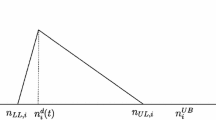Abstract
The aim of this paper is to face the manpower planning problem from a continuous time optimal control perspective. A new continuous-time manpower planning model is proposed in which the promotions occur inside the system. The proposed model contains four main sections: applicants, newcomers, experienced employees and supervisors (or managers). Each of these sections has a target value which we try to attain them by applying appropriate control variables, such as lay off, degradation, promotion and retirement. To attain the targets, we formulated an optimal control problem using a linear system transition equation with a quadratic cost functional. Finally, the proposed model is applied for a real-world organization as a case study.




Similar content being viewed by others
References
Bouajaja S, Dridi N (2017) A survey on human resource allocation problem and its applications. Oper Res 17:339–369
Defraeye M, Van Nieuwenhuyse I (2016) Staffing and scheduling under nonstationary demand for service: a literature review. Omega 58:4–25
de Leeuw S, Wiers VCS (2015) Warehouse manpower planning strategies in times of financial crisis: evidence from logistics service providers and retailers in the Netherlands. Prod Plan Control 26.4:328–337
Egilmez G, Erenay B, Ser GA (2014) Stochastic skill-based manpower allocation in a cellular manufacturing system. J Manuf Syst 33(4):578–588
Francesco Di M (2016) An optimization model for the short-term manpower planning problem in transhipment container terminals. Comput Ind Eng 97:183–190
Glen JJ, Yang CL (1996) A model for promotion rate control in hierarchical manpower systems. IMA J Manag Math 7(3):197–206
Goyal SK, Eiselt HA (1993) Manpower planning for maintenance jobs in process industries. Prod Plan Control 4(4):344–348
Grinold RC, Stanford RE (1974) Optimal control of a graded manpower system. Manag Sci 20(8):1201–1216
Hedjar R, Garg AK, Tadj L (2015) Model predictive production planning in a three-stock reverse-logistics system with deteriorating items. Int J Syst Sci Oper Log 2.4:187–198
Hedjar R, Tadj L, Abid C (2012) Optimal control of integrated production-forecasting system. In: Decision support systems, InTech. https://doi.org/10.5772/51974
Hesham AM, Kagaya S, Yamamura E (1991) The distribution of manpower in cairo based on optimal control systems. Stud Reg Sci 21(1):87–112
James DJG, Rumchev VG (1989) Linear-feedback recruitment polices for constant-size manpower systems. IMA J Manag Math 2(4):319–328
Ku C-Y et al (2006) Near-optimal control policy for loss networks. Omega 34.4:406–416
Lagodimos AG, Paravantis JA (2006) Improved heuristic for manpower shift planning with modified shift priorities. Prod Plan Control 17(3):301–310
Lazaridis A (2015) Dynamic systems in management science, design, estimation and control. Palgrave Macmillan, Basingstoke
Lee HWJ, Cai XQ, Teo KL (2001) An optimal control approach to manpower planning problem. Math Probl Eng 7(2):155–175
Lewis FL, Vrabie DL, Syrmos VL (2012) Optimal Control, 3rd edn. Wiley, Hoboken
Mouza A-M (2010) Application of optimal control in man power planning. Qual Quantit 44(2):199–215
Nilakantan K, Raghavendra BG (2008) Length of service and age characteristics in proportionality Markov manpower systems. IMA J Manag Math 19(3):245–268
Pooya A, Pakdaman M (2017) Analysing the solution of production-inventory optimal control systems by neural networks. RAIRO-Oper Res 51:577–590
Pooya A, Pakdaman M (2018a) A delayed optimal control model for multi-stage production-inventory system with production lead times. Int J Adv Manuf Technol 94:751761
Pooya A, Pakdaman M (2018b) Optimal control model for finite capacity continuous MRP with deteriorating items. J Intell Manuf. https://doi.org/10.1007/s10845-017-1383-6
Pooya A, Pakdaman M, Tadj L (2017) Exact and approximate solution for optimal inventory control of two-stock with reworking and forecasting of demand. Oper Res. https://doi.org/10.1007/s12351-017-0297-6
Shahnazari-Shahrezaei P, Tavakkoli-Moghaddam R, Kazemipoor H (2013) Solving a new fuzzy multi-objective model for a multi-skilled manpower scheduling problem by particle swarm optimization and elite tabu search. Int J Adv Manuf Technol 64:1–24
Stone DL, Deadrick DL (2015) Challenges and opportunities affecting the future of human resource management. Hum Res Manag Rev 25(2):139–145
Talarico L, Duque PAM (2015) An optimization algorithm for the workforce management in a retail chain. Comput Ind Eng 82:65–77
Udom AU (2014) Optimal controllability of manpower system with linear quadratic performance index. Braz J Probab Stat 28(2):151–166
Udom AU (2013) Some majorisation results in optimal manpower control. Int J Oper Res 16(3):287–303
Author information
Authors and Affiliations
Corresponding author
Ethics declarations
Conflict of interest
The authors declare that they have no conflict of interest.
Additional information
This work was supported in part by: Research Deputy of Ferdowsi University of Mashhad, under Grant No. 42741 (dated February 8, 2017)
Rights and permissions
About this article
Cite this article
Pooya, A., Pakdaman, M. A new continuous time optimal control model for manpower planning with promotion from inside the system. Oper Res Int J 21, 349–364 (2021). https://doi.org/10.1007/s12351-018-0431-0
Received:
Revised:
Accepted:
Published:
Issue Date:
DOI: https://doi.org/10.1007/s12351-018-0431-0




